曼昆微观经济学答案ch10
曼昆经济学原理微观经济学第五版课后习题解答

曼昆《微观经济学原理》课后习题答案

第一篇导言第一章经济学十大原理复习题1.列举三个你在生活中面临的重要权衡取舍的例子。
答:①大学毕业后,面临着是否继续深造的选择,选择继续上学攻读研究生学位,就意味着在今后三年中放弃参加工作、赚工资和积累社会经验的机会;②在学习内容上也面临着很重要的权衡取舍,如果学习《经济学》,就要减少学习英语或其他专业课的时间;③对于不多的生活费的分配同样面临权衡取舍,要多买书,就要减少在吃饭、买衣服等其他方面的开支。
2.看一场电影的机会成本是什么?答:看一场电影的机会成本是在看电影的时间里做其他事情所能获得的最大收益,例如:看书、打零工。
3.水是生活必需的。
一杯水的边际利益是大还是小呢?答:这要看这杯水是在什么样的情况下喝,如果这是一个人五分钟内喝下的第五杯水,那么他的边际利益很小,有可能为负;如果这是一个极度干渴的人喝下的第一杯水,那么他的边际利益将会极大。
4.为什么决策者应该考虑激励?答:因为人们会对激励做出反应。
如果政策改变了激励,它将使人们改变自己的行为,当决策者未能考虑到行为如何由于政策的原因而变化时,他们的政策往往会产生意想不到的效果。
5.为什么各国之间的贸易不像竞赛一样有赢家和输家呢?答:因为贸易使各国可以专门从事自己最擅长的活动,并从中享有更多的各种各样的物品与劳务。
通过贸易使每个国家可供消费的物质财富增加,经济状况变得更好。
因此,各个贸易国之间既是竞争对手,又是经济合作伙伴。
在公平的贸易中是“双赢”或者“多赢”的结果。
6.市场中的那只“看不见的手”在做什么呢?答:市场中那只“看不见的手”就是商品价格,价格反映商品自身的价值和社会成本,市场中的企业和家庭在作出买卖决策时都要关注价格。
因此,他们也会不自觉地考虑自己行为的(社会)收益和成本。
从而,这只“看不见的手”指引着千百万个体决策者在大多数情况下使社会福利趋向最大化。
7.解释市场失灵的两个主要原因,并各举出一个例子。
答:市场失灵的主要原因是外部性和市场势力。
曼昆《经济学原理》第6版微观经济学分册课后习题答案第10章
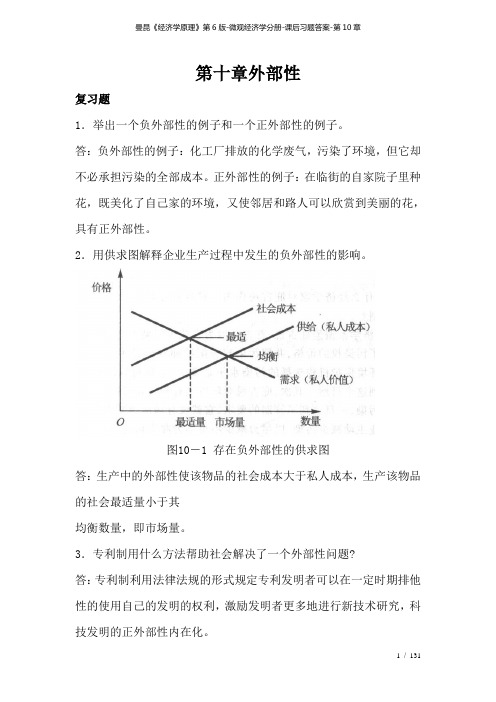
第十章外部性复习题1.举出一个负外部性的例子和一个正外部性的例子。
答:负外部性的例子:化工厂排放的化学废气,污染了环境,但它却不必承担污染的全部成本。
正外部性的例子:在临街的自家院子里种花,既美化了自己家的环境,又使邻居和路人可以欣赏到美丽的花,具有正外部性。
2.用供求图解释企业生产过程中发生的负外部性的影响。
图10-1 存在负外部性的供求图答:生产中的外部性使该物品的社会成本大于私人成本,生产该物品的社会最适量小于其均衡数量,即市场量。
3.专利制用什么方法帮助社会解决了一个外部性问题?答:专利制利用法律法规的形式规定专利发明者可以在一定时期排他性的使用自己的发明的权利,激励发明者更多地进行新技术研究,科技发明的正外部性内在化。
4.什么是矫正税?为什么就保护环境免受污染的方法而言,经济学家对矫正税的偏好大于管制?用于纠正负外部性影响的税收被称为矫正税。
这种税也被称为庇古税。
作为解决污染的方法,经济学家对矫正税的偏爱通常大于管制,因为税收可以以较低的社会成本减少污染。
首先是因为税收减少污染更有效率。
矫正税实际上规定了污染权的价格,并把污染权分配给那些减少污染成本最高的工厂。
无论环境保护机构选择的污染水平是多少,它都可以通过税收以最低的总成本达到这个目标。
其次,矫正税对环境更有利。
在管制政策下,企业被动地减少污染,一旦达到了管制的要求,它就没有理由再减少排污。
税收激励工厂主动减少污染,以尽力减少不得不为此支付的税收量。
5.列出不用政府干预时也可以解决外部性引起的问题的一些方法。
答:私人解决外部性所引起的问题的方法有:(1)用道德规范和社会约束来解决;(2)慈善行为;(3)通过依靠有关各方的私利来解决外部性问题;(4)利益各方签订合约。
6.设想你与一个吸烟者同住一间房,但你不吸烟。
根据科斯定理,什么因素决定了你的室友是否在房间里吸烟?这个结果有效率吗?你和你室友如何达成这种解决方法?答:根据科斯定理,如果我被迫吸烟所承受的成本大于我的室友吸烟所获得的收益,我的室友就不应该在房间里吸烟。
(微观 宏观全)曼昆《经济学原理》(第五版)课后习题答案-中文版

曼昆《经济学原理》(第五版)习题解答目录第一章经济学十大原理 (1)第二章像经济学家一样思考 (7)第三章相互依存性与贸易的好处 (14)第四章供给与需求的市场力量 (22)第五章弹性及其应用 (31)第六章供给、需求与政府政策 (41)第七章消费者、生产者与市场效率 (50)第八章应用:赋税的代价 (58)第九章应用:国际贸易 (65)第十章外部性 (75)第十一章公共物品和公共资源 (84)第十二章税制的设计 (91)第十三章生产成本 (99)第十四章竞争市场上的企业 (109)第十五章垄断 (121)第十六章垄断竞争 (135)第十七章寡头 (143)第十八章生产要素市场 (153)第十九章收入与歧视 (162)第二十章收入不平等与贫困 (169)第二十一章消费者选择理论 (177)第二十二章微观经济学前沿 (187)第二十三章一国收入的衡量 (195)第二十四章生活费用的衡量 (204)第二十五章生产与增长 (210)第二十六章储蓄、投资和金融体系 (214)第二十七章基本金融工具 (221)第二十八章失业 (226)第一篇导言第一章经济学十大原理复习题1.列举三个你在生活中面临的重要权衡取舍的例子。
答:①大学毕业后,面临着是否继续深造的选择,选择继续上学攻读研究生学位,就意味着在今后三年中放弃参加工作、赚工资和积累社会经验的机会;②在学习内容上也面临着很重要的权衡取舍,如果学习《经济学》,就要减少学习英语或其他专业课的时间;③对于不多的生活费的分配同样面临权衡取舍,要多买书,就要减少在吃饭、买衣服等其他方面的开支。
2.看一场电影的机会成本是什么?答:看一场电影的机会成本是在看电影的时间里做其他事情所能获得的最大收益,例如:看书、打零工。
3.水是生活必需的。
一杯水的边际利益是大还是小呢?答:这要看这杯水是在什么样的情况下喝,如果这是一个人五分钟内喝下的第五杯水,那么他的边际利益很小,有可能为负;如果这是一个极度干渴的人喝下的第一杯水,那么他的边际利益将会极大。
曼昆《经济学原理微观经济学分册》课后习题详解第1篇
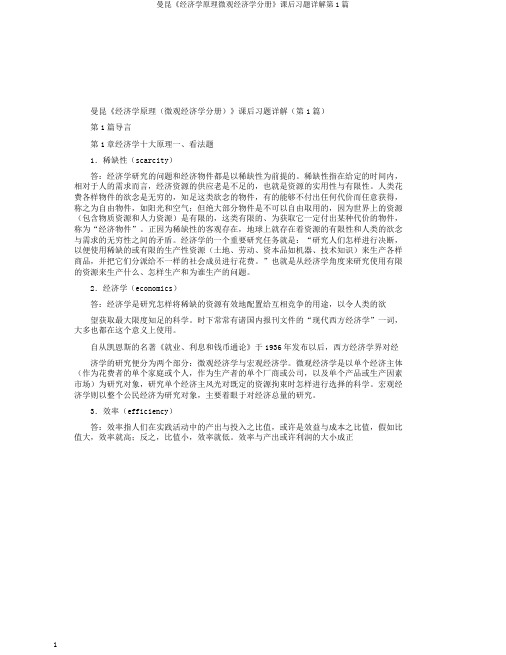
曼昆《经济学原理(微观经济学分册)》课后习题详解(第1篇)第1篇导言第1章经济学十大原理一、看法题1.稀缺性(scarcity)答:经济学研究的问题和经济物件都是以稀缺性为前提的。
稀缺性指在给定的时间内,相对于人的需求而言,经济资源的供应老是不足的,也就是资源的实用性与有限性。
人类花费各样物件的欲念是无穷的,知足这类欲念的物件,有的能够不付出任何代价而任意获得,称之为自由物件,如阳光和空气;但绝大部分物件是不可以自由取用的,因为世界上的资源(包含物质资源和人力资源)是有限的,这类有限的、为获取它一定付出某种代价的物件,称为“经济物件”。
正因为稀缺性的客观存在,地球上就存在着资源的有限性和人类的欲念与需求的无穷性之间的矛盾。
经济学的一个重要研究任务就是:“研究人们怎样进行决断,以便使用稀缺的或有限的生产性资源(土地、劳动、资本品如机器、技术知识)来生产各样商品,并把它们分派给不一样的社会成员进行花费。
”也就是从经济学角度来研究使用有限的资源来生产什么、怎样生产和为谁生产的问题。
2.经济学(economics)答:经济学是研究怎样将稀缺的资源有效地配置给互相竞争的用途,以令人类的欲望获取最大限度知足的科学。
时下常常有诸国内报刊文件的“现代西方经济学”一词,大多也都在这个意义上使用。
自从凯恩斯的名著《就业、利息和钱币通论》于1936年发布以后,西方经济学界对经济学的研究便分为两个部分:微观经济学与宏观经济学。
微观经济学是以单个经济主体(作为花费者的单个家庭或个人,作为生产者的单个厂商或公司,以及单个产品或生产因素市场)为研究对象,研究单个经济主风光对既定的资源拘束时怎样进行选择的科学。
宏观经济学则以整个公民经济为研究对象,主要着眼于对经济总量的研究。
3.效率(efficiency)答:效率指人们在实践活动中的产出与投入之比值,或许是效益与成本之比值,假如比值大,效率就高;反之,比值小,效率就低。
效率与产出或许利润的大小成正比,而与成本或投入成反比,也就是说,假如想提升效率,一定降低成本或投入,提升利润或产出。
微观--曼昆经济学原理-课后答案

第一章经济学十大原理复习题4.为什么决策者应该考虑激励?答:因为人们会对激励做出反应。
如果政策改变了激励,它将使人们改变自己的行为,当决策者未能考虑到行为如何由于政策的原因而变化时,他们的政策往往会产生意想不到的效果。
6.市场中的那只“看不见的手”在做什么呢?答:市场中那只“看不见的手”就是商品价格,价格反映商品自身的价值和社会成本,市场中的企业和家庭在作出买卖决策时都要关注价格。
因此,他们也会不自觉地考虑自己行为的(社会)收益和成本。
从而,这只“看不见的手”指引着千百万个体决策者在大多数情况下使社会福利趋向最大化。
7.解释市场失灵的两个主要原因,并各举出一个例子。
答:市场失灵的主要原因是外部性和市场势力。
外部性是一个人的行为对旁观者福利的影响。
当一个人不完全承担(或享受)他的行为所造成的成本(或收益)时,就会产生外部性。
举例:如果一个人不承担他在公共场所吸烟的全部成本,他就会毫无顾忌地吸烟。
在这种情况下,政府可以通过制定禁止在公共场所吸烟的规章制度来增加经济福利。
市场势力是指一个人(或一小群人)不适当地影响市场价格的能力。
例如:某种商品的垄断生产者由于几乎不受市场竞争的影响,可以向消费者收取过高的垄断价格。
在这种情况下,规定垄断者收取的价格有可能提高经济效率。
9.什么是通货膨胀,什么引起了通货膨胀?答:通货膨胀是流通中货币量的增加而造成的货币贬值,由此产生经济生活中价格总水平上升。
货币量增长引起了通货膨胀。
10.短期中通货膨胀与失业如何相关?答:短期中通货膨胀与失业之间存在着权衡取舍,这是由于某些价格调整缓慢造成的。
政府为了抑制通货膨胀会减少流通中的货币量,人们可用于支出的货币数量减少了,但是商品价格在短期内是粘性的,仍居高不下,于是社会消费的商品和劳务量减少,消费量减少又引起企业解雇工人。
在短期内,对通货膨胀的抑制增加了失业量。
问题与应用7.社会保障制度为65岁以上的人提供收入。
如果一个社会保障的领取者决定去工作并赚一些钱,他(或她)所领到的社会保障津贴通常会减少。
曼昆微观经济学原理第五版课后习题答案
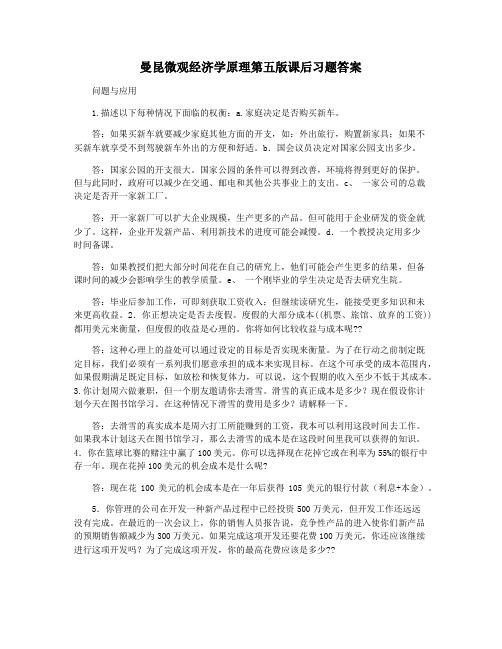
曼昆微观经济学原理第五版课后习题答案问题与应用1.描述以下每种情况下面临的权衡:a.家庭决定是否购买新车。
答:如果买新车就要减少家庭其他方面的开支,如:外出旅行,购置新家具;如果不买新车就享受不到驾驶新车外出的方便和舒适。
b.国会议员决定对国家公园支出多少。
答:国家公园的开支很大。
国家公园的条件可以得到改善,环境将得到更好的保护。
但与此同时,政府可以减少在交通、邮电和其他公共事业上的支出。
c、一家公司的总裁决定是否开一家新工厂。
答:开一家新厂可以扩大企业规模,生产更多的产品。
但可能用于企业研发的资金就少了。
这样,企业开发新产品、利用新技术的进度可能会减慢。
d.一个教授决定用多少时间备课。
答:如果教授们把大部分时间花在自己的研究上,他们可能会产生更多的结果,但备课时间的减少会影响学生的教学质量。
e、一个刚毕业的学生决定是否去研究生院。
答:毕业后参加工作,可即刻获取工资收入;但继续读研究生,能接受更多知识和未来更高收益。
2.你正想决定是否去度假。
度假的大部分成本((机票、旅馆、放弃的工资))都用美元来衡量,但度假的收益是心理的。
你将如何比较收益与成本呢??答:这种心理上的益处可以通过设定的目标是否实现来衡量。
为了在行动之前制定既定目标,我们必须有一系列我们愿意承担的成本来实现目标。
在这个可承受的成本范围内,如果假期满足既定目标,如放松和恢复体力,可以说,这个假期的收入至少不低于其成本。
3.你计划周六做兼职,但一个朋友邀请你去滑雪。
滑雪的真正成本是多少?现在假设你计划今天在图书馆学习。
在这种情况下滑雪的费用是多少?请解释一下。
答:去滑雪的真实成本是周六打工所能赚到的工资,我本可以利用这段时间去工作。
如果我本计划这天在图书馆学习,那么去滑雪的成本是在这段时间里我可以获得的知识。
4.你在篮球比赛的赌注中赢了100美元。
你可以选择现在花掉它或在利率为55%的银行中存一年。
现在花掉100美元的机会成本是什么呢?答:现在花100美元的机会成本是在一年后获得105美元的银行付款(利息+本金)。
曼昆微观经济学课后标准答案

曼昆微观经济学课后答案作者: 日期:1 .C on sider the market for DVD movies,TV scree ns,a nd ticket at movie theaters.A •对每一对物品,确定它们是互补品还是替代品・DVD和电视・DVD和电影票・电视和电影票As: compleme nts substitutes substitutesB •假设技术进步降低了制造电视机的成本。
画一个图说明电视机市场会发生什么变动。
As: dema nd curve不娈supply curve向右移:技术进步降低了制造电视机的成本,使电视机的供给曲线向右移动。
电视机的需求曲线不变。
电视机的均衡价格下降,均衡价格上升。
C .再画两个图说明电视机市场的变动如何影响DVD市场和电影票市场。
答:DVD : dema nd curve不变supply curve向右移。
由于电视机和DVD是互补品,电视机价格的下降使DVD的需求增加。
需求增加引起DVD均衡价格上升,均衡数量增加。
Movie tickets : supply curve不变dema nd curve向左移。
由于电视机和电影票是替代品,电视机价格的下降使电影票需求减少。
需求的减少使电影票的均衡价格下降,均衡数量减少。
2.Over the past 20 years,tech no logical adva nee reduces the cost of computer chips.How do you think this affected the market for computers?For computer software?For typewriters?As: computer: supply curve 向右彳多price 卜降3.Consider total cost and total revenue given in the following table:产量01234567总成本89101113192737总收益08162432404856computer software: supply curve 向右彳多price 卜•降软件厂、・i) o _—八j IX2I uWhen MR=MC profit maximum 即Q=6 TC=27B・计算每种产量时的边际收益和边际成本。
曼昆微观经济学答案

曼昆微观经济学答案第四章复习题1.在索洛模型中,更高的储蓄率将导致在稳定状态时有更高的资本存量,从而导致更高的经济产出。
反之,亦然。
如果增加储蓄率将增加稳定状态时的资本存量,增加新的稳定状态的经济产出,从而导致经济增长。
但是,达到稳定状态后,经济将不再增长。
2.这个问题的前提在于经济决策者更关心的整个社会的福利水平,而不是关注最终的产出水平。
因为,在尽可能简单的情况下,社会福利水平与消费量相关,所以,最大化社会福利水平问题就转化为一个消费量最大化问题。
而在黄金规则下,意味着达到稳定状态时,有最大的消费量。
因此,决策者会选择黄金规则的资本水平。
3.应该说,决策者对这两种情况都可能选择,只是看本国情况的不同而定。
因为:无论经济从高于还是低于黄金规则资本存量开始,则达到的新稳定状态的消费水平都将高于最初的稳定状态。
但如果经济从高于黄金规则资本存量开始,则意味着当期的消费水平会上升,此后逐步下降;而如果经济从低于黄金规则资本存量开始,则意味着可能要减少当期的消费水平以获得远期更高的消费水平。
如此看来,如果不选择黄金规则资本存量,则各期的消费水平会有所不同,也就可能造成不同世代的人的福利水平不同。
4.在一定的储蓄率下,人口增长率越高,则稳定状态资本越低,导致的产出水平也越低;反之,稳定状态资本越高,产出水平也就越高。
因此,人口增长率将影响稳定状态产出水平的高低,从而影响经济增长率。
可以通过改变储蓄率来改变经济增长率。
比如:要达到一定的经济增长率,如果人口增长率高,则要求更高的储蓄率;人口增长率低,储蓄率则较低。
问题与应用1.a)Y = F(K, L) = K1/2L1/2,将投入要素都变成原来的z倍,上式变为:Y = F(z K, z L) = z K1/2L1/2,因此,该生产函数的规模收益不变。
b)Y = F(K, L) = K1/2L1/2Y/L = F(K, L)/L = K1/2L1/2/L=(K/L)1/2即:y = f (k) = k1/2c) 在稳定状态下,资本存量不再发生变动。
曼昆《经济学原理(微观经济学分册)》(第6版)课后习题详解(第10章 外部性)
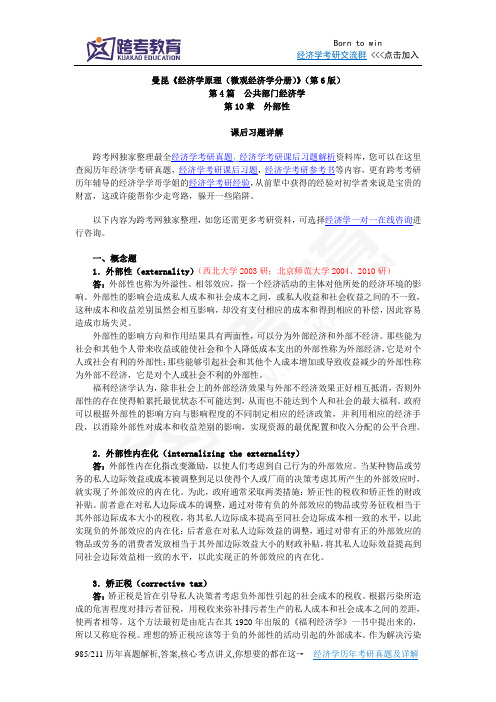
曼昆《经济学原理(微观经济学分册)》(第6版)第4篇公共部门经济学第10章外部性课后习题详解跨考网独家整理最全经济学考研真题,经济学考研课后习题解析资料库,您可以在这里查阅历年经济学考研真题,经济学考研课后习题,经济学考研参考书等内容,更有跨考考研历年辅导的经济学学哥学姐的经济学考研经验,从前辈中获得的经验对初学者来说是宝贵的财富,这或许能帮你少走弯路,躲开一些陷阱。
以下内容为跨考网独家整理,如您还需更多考研资料,可选择经济学一对一在线咨询进行咨询。
一、概念题1.外部性(externality)(西北大学2003研;北京师范大学2004、2010研)答:外部性也称为外溢性、相邻效应,指一个经济活动的主体对他所处的经济环境的影响。
外部性的影响会造成私人成本和社会成本之间,或私人收益和社会收益之间的不一致,这种成本和收益差别虽然会相互影响,却没有支付相应的成本和得到相应的补偿,因此容易造成市场失灵。
外部性的影响方向和作用结果具有两面性,可以分为外部经济和外部不经济。
那些能为社会和其他个人带来收益或能使社会和个人降低成本支出的外部性称为外部经济,它是对个人或社会有利的外部性;那些能够引起社会和其他个人成本增加或导致收益减少的外部性称为外部不经济,它是对个人或社会不利的外部性。
福利经济学认为,除非社会上的外部经济效果与外部不经济效果正好相互抵消,否则外部性的存在使得帕累托最优状态不可能达到,从而也不能达到个人和社会的最大福利。
政府可以根据外部性的影响方向与影响程度的不同制定相应的经济政策,并利用相应的经济手段,以消除外部性对成本和收益差别的影响,实现资源的最优配置和收入分配的公平合理。
2.外部性内在化(internalizing the externality)答:外部性内在化指改变激励,以使人们考虑到自己行为的外部效应。
当某种物品或劳务的私人边际效益或成本被调整到足以使得个人或厂商的决策考虑其所产生的外部效应时,就实现了外部效应的内在化。
曼昆微观经济学课后答案

-
-
-
.
.对每一对物品,确定它们是互补品还是替代品
·和电视·和电影票·电视和电影票
:
.假设技术进步降低了制造电视机的成本。画一个图说明电视机市场会发生什么变动。
:不变向右移。技术进步降低了制造电视机的成本,使电视机的供给曲线向右降,均衡价格上升。
.再画两个图说明电视机市场的变动如何影响市场和电影票市场。
答::不变向右移。由于电视机和是互补品,电视机价格的下降使的需求增加。需求增加引起均衡价格上升,均衡数量增加。
:不变向左移。由于电视机和电影票是替代品,电视机价格的下降使电影票需求减少。需求的减少使电影票的均衡价格下降,均衡数量减少。
?
: :向右移下降
:向右移下降
:向左移
:
产量
总成本
总收益
.计算每种产量时的利润。企业为了使利润最大化应该生产多少?
曼昆微观经济学课后答案

曼昆微观经济学课后答案 Last revision date: 13 December 2020.第二篇市场如何运作第四章供给与需求的市场力量复习题1.什么是竞争市场?简单描述一种不是完全竞争的市场。
答:竞争市场是有许多买者与卖者,以至于每个人对市场价格的影响都微乎其微的市场。
除了完全竞争市场之外,还有垄断市场。
在这个市场上只有一个卖者,他决定价格。
这个卖者被称为垄断者。
还有寡头市场,在这个市场上有几个并不总是主动竞争的卖者,他们提供相似或相同的产品。
通常情况下,寡头们会尽力联合起来,避免激烈的竞争,收取较高的市场价格。
还有垄断竞争市场,这是一个有许多提供相似但不相同产品的企业的市场结构。
由于各自提供的产品不同,每个企业对产品的价格都有一定的影响力。
2.什么因素决定买者对一种物品的需求量?答:物品的价格、买者的收入水平、相关物品的价格、买者的偏好和对物品的价格预期。
3.什么是需求表和需求曲线它们之间是什么关系为什么需求曲线向右下方倾斜答:需求表是表示一种物品价格与需求量之间关系的表格,需求曲线是表示一种物品价格与需求量之间关系的图形。
需求曲线将需求表用图形的形式表现出来,需求表是需求曲线上若干个点的坐标的数字表格排列。
需求曲线向右下方倾斜是因为在其他条件不变的情况下,随着价格上升,需求量会减少。
4.消费者嗜好的变化引起了沿着需求曲线的变动,还是需求曲线的移动?价格的变化引起了沿着需求曲线的变动,还是需求曲线的移动?答:消费者嗜好的变化引起了需求曲线的移动,价格的变化引起了沿着需求曲线的变动。
5.Popeye的收入减少了,结果他买了更多的菠菜。
菠菜是低档物品,还是正常物品?Popeye 的菠菜需求14曲线会发生什么变化?答:根据低档物品的定义,菠菜对Popeye 来说是低档物品。
因为Popeye 的收入减少了,他对菠菜的需求量反而增大了。
对于低档物品来说,需求曲线是向右下方倾斜的,收入增加会引起需求曲线向外移动。
曼昆《经济学原理(微观经济学分册)》课后习题及详解(微观经济学前沿)【圣才出品】

曼昆《经济学原理(微观经济学分册)》课后习题及详解(微观经济学前沿)【圣才出品】第22章微观经济学前沿⼀、概念题1.道德风险(moral hazard)答:道德风险指⼀个没有受到完全监督的⼈从事不忠诚或不合意⾏为的倾向。
换句话说,道德风险是在双⽅信息⾮对称的情况下,⼈们享有⾃⼰⾏为的收益,⽽将成本转嫁给别⼈,从⽽造成他⼈损失的可能性。
道德风险的存在不仅使得处于信息劣势的⼀⽅受到损失,⽽且会破坏原有的市场均衡,导致资源配置的低效率。
在信息不对称的情况下,当代理⼈为委托⼈⼯作⽽其⼯作成果同时取决于代理⼈所做的主观努⼒和不由主观意志决定的各种客观因素,并且主观原因对委托⼈来说难以区别时,就会产⽣代理⼈隐瞒⾏动⽽导致对委托⼈利益损害的“道德风险”。
道德风险发⽣的⼀个典型领域是保险市场。
解决道德风险的主要⽅法是风险分担。
2.代理⼈(agent)答:代理⼈指⼀个为委托⼈完成某种⾏为的⼈。
这⾥的“⼈”,可以是⾃然⼈或法⼈。
在现实经济⽣活中,代理⼈的种类很多,如销售代理商、企业代理商、专利代理⼈、⼴告代理⼈、保险代理⼈、税务代理⼈等。
在现代微观经济学中,企业的管理者可以被看成是所有者的代理⼈。
随着分⼯和专业化的发展,交易和契约活动中的委托—代理关系成为现代经济中的重要问题。
在公司制度中,由于所有权和控制权、经营权的分离,导致了所有者和管理者之间潜在的利益⽭盾。
特别是在⼀些⼤型股份公司⾥,如果股权极其分散,对管理者的控制和影响就更弱了。
管理者是为了⾃⼰的利益最⼤化⽽⼯作,⽽不是为了股东利益最⼤化。
⽽委托—代理问题的重要之处在于,由于代理⼈的某些信息或某些⾏动是不可观察的,或者虽然可观察但不可确证,委托⼈难以通过⼀个直接的强制性契约来实现⾃⼰的利益最⼤化,⽽只能通过⼀个间接的激励⽅案,使代理⼈在追求⾃我利益的最⼤化实现的同时,也使委托⼈的利益尽可能地得到实现。
3.委托⼈(principal)答:委托⼈指让代理⼈完成某种⾏为的⼈。
(NEW)曼昆《经济学原理(微观经济学分册)》(第6版)课后习题详解
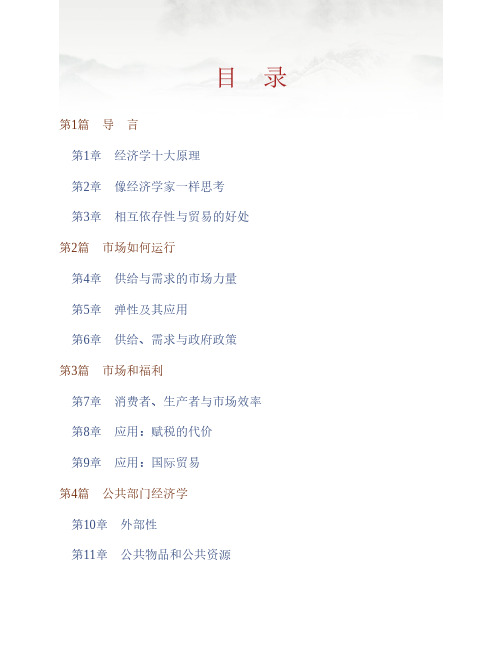
目 录第1篇 导 言第1章 经济学十大原理第2章 像经济学家一样思考第3章 相互依存性与贸易的好处第2篇 市场如何运行第4章 供给与需求的市场力量第5章 弹性及其应用第6章 供给、需求与政府政策第3篇 市场和福利第7章 消费者、生产者与市场效率第8章 应用:赋税的代价第9章 应用:国际贸易第4篇 公共部门经济学第10章 外部性第11章 公共物品和公共资源第12章 税制的设计第5篇 企业行为与产业组织第13章 生产成本第14章 竞争市场上的企业第15章 垄 断第16章 垄断竞争第17章 寡 头第6篇 劳动市场经济学第18章 生产要素市场第19章 收入与歧视第20章 收入不平等与贫困第7篇 深入研究的论题第21章 消费者选择理论第22章 微观经济学前沿第1篇 导 言第1章 经济学十大原理一、概念题1.稀缺性(scarcity)答:经济学研究的问题和经济物品都是以稀缺性为前提的。
稀缺性指在给定的时间内,相对于人的需求而言,经济资源的供给总是不足的,也就是资源的有用性与有限性。
人类消费各种物品的欲望是无限的,满足这种欲望的物品,有的可以不付出任何代价而随意取得,称之为自由物品,如阳光和空气;但绝大多数物品是不能自由取用的,因为世界上的资源(包括物质资源和人力资源)是有限的,这种有限的、为获取它必须付出某种代价的物品,称为“经济物品”。
正因为稀缺性的客观存在,地球上就存在着资源的有限性和人类的欲望与需求的无限性之间的矛盾。
经济学的一个重要研究任务就是:“研究人们如何进行抉择,以便使用稀缺的或有限的生产性资源(土地、劳动、资本品如机器、技术知识)来生产各种商品,并把它们分配给不同的社会成员进行消费。
”也就是从经济学角度来研究使用有限的资源来生产什么、如何生产和为谁生产的问题。
2.经济学(economics)答:经济学是研究如何将稀缺的资源有效地配置给相互竞争的用途,以使人类的欲望得到最大限度满足的科学。
时下经常见诸国内报刊文献的“现代西方经济学”一词,大多也都在这个意义上使用。
曼昆微观经济学(第三版)课后习题答案
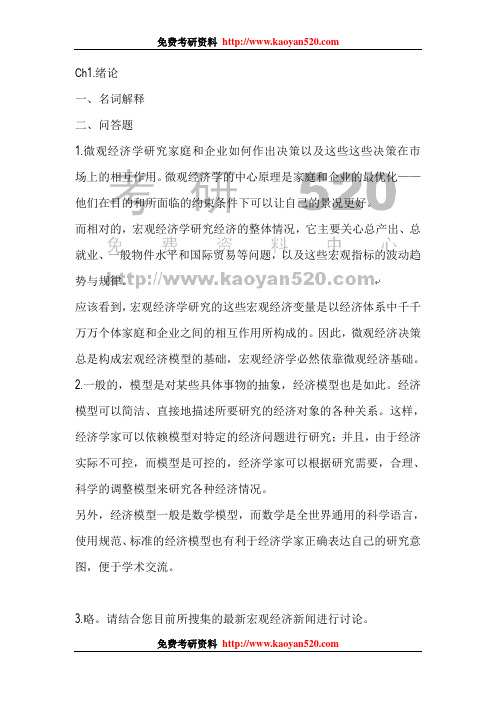
Ch1.绪论一、名词解释二、问答题1.微观经济学研究家庭和企业如何作出决策以及这些这些决策在市场上的相互作用。
微观经济学的中心原理是家庭和企业的最优化——他们在目的和所面临的约束条件下可以让自己的景况更好。
而相对的,宏观经济学研究经济的整体情况,它主要关心总产出、总就业、一般物件水平和国际贸易等问题,以及这些宏观指标的波动趋势与规律。
应该看到,宏观经济学研究的这些宏观经济变量是以经济体系中千千万万个体家庭和企业之间的相互作用所构成的。
因此,微观经济决策总是构成宏观经济模型的基础,宏观经济学必然依靠微观经济基础。
2.一般的,模型是对某些具体事物的抽象,经济模型也是如此。
经济模型可以简洁、直接地描述所要研究的经济对象的各种关系。
这样,经济学家可以依赖模型对特定的经济问题进行研究;并且,由于经济实际不可控,而模型是可控的,经济学家可以根据研究需要,合理、科学的调整模型来研究各种经济情况。
另外,经济模型一般是数学模型,而数学是全世界通用的科学语言,使用规范、标准的经济模型也有利于经济学家正确表达自己的研究意图,便于学术交流。
3.略。
请结合您目前所搜集的最新宏观经济新闻进行讨论。
4.市场出清模型就是供给与需求可以在价格机制调整下很快达到均衡的模型。
市场出清模型的前提条件是价格是具有伸缩性的(或弹性)。
但是,我们知道,价格具有伸缩性是一个很强的假设,在很多实际情况下,这个假设都是不现实的。
比如:劳动合同会使劳动力价格在一段时期内具有刚性。
因此,我们必须考虑什么情况下价格具有伸缩性是合适的。
现在一般地认为,在研究长期问题时,假设价格具有伸缩性是合理的;而在研究短期问题时,最好假设价格具有刚性。
因为,从长期看,价格机制终将发挥作用,使市场供需平衡,即市场出清,而在短期,价格机制因其他因素制约,难以很快使市场出清。
5.一般的,人们认为科学的定义是:一种建立稳定关系的科学的研究方法。
比如:物理学家可以通过实验来收集数据,证明或推翻一个假设。
ch10 小型开放经济 __华科曼昆宏观

Ch10 小型开放经济一、名词解释净出口贸易余额贸易盈余与贸易赤字名义汇率实际汇率购买力平价小型开放经济世界利率二、选择题1.实际汇率升高,则()A国外物品变得相对便宜B国内净出口减少C贸易余额减少D以上都对2.如果美国一台计算机售价5000美元,名义汇率为2德国马克/美元,那么在德国该计算机多少钱?()A5000德国马克B2500德国马克C10000德国马克D5002德国马克3.如果国内投资大于国内储蓄,那么存在()A国外净投资为负B政府预算赤字C贸易赤字Da和c4.假设国民产出Y=1000,国内对所有物品与劳务的支出等于900,净出口等于:()A100B-100C1900D05.一个小型开放经济的政府增加个人所得税,该国的()A净出口增加B投资增加C均衡实际汇率增加D消费增加6.某一国际化产品在美国售价5000美元,在德国售价20000马克。
如果名义汇率为2马克/美元,那么美元的实际汇率(也即一个美国物品的花费能购买的德国物品的数量)为()A8B4C2D0.5三、问答题1.什么是国外净投资和贸易余额?解释它们如何相关。
2.如果一个小型开放经济削减国际支出,则储蓄、贸易余额、利率以及汇率会发生什么变动?3.如果一个小型开放经济禁止日本VCRS进口,则储蓄、投资、贸易余额、利率,以及汇率会发生什么变动?4.如果德国是低通货膨胀而意大利是高通货膨胀,德国马克和意大利里拉之间的汇率会发生什么变动?5.用小型开放模型预测,在下列每个事件时,贸易余额、实际汇率和名义汇率会发生什么变动?a.消费者对未来的信心下降引起消费者消费更少而储蓄增加b.引进丰田的新型生产线使消费者对外国汽车的偏好大于本国汽车c.引进自动取款机减少了货币需求6.利维瑞特国是一个小型开放经济。
突然,世界时尚的变动使该国的出口品不受欢迎。
a.利维瑞特国的储蓄、投资、净出口、利率,以及汇率会发生什么变动?b.利维瑞特的公民喜欢到国外旅游。
曼昆_微观经济学_原理_第五版_课后习题答案

问题与应用1.描写下列每种情况所面临的权衡取舍:A.一个家庭决定是否买一辆新车。
答:如果买新车就要减少家庭其他方面的开支,如:外出旅行,购置新家具;如果不买新车就享受不到驾驶新车外出的方便和舒适。
B.国会议员决定对国家公园支出多少。
答:对国家公园的支出数额大,国家公园的条件可以得到改善,环境会得到更好的保护。
但同时,政府可用于交通、邮电等其他公共事业的支出就会减少。
C.一个公司总裁决定是否新开一家工厂。
答:开一家新厂可以扩大企业规模,生产更多的产品。
但可能用于企业研发的资金就少了。
这样,企业开发新产品、利用新技术的进度可能会减慢。
D.一个教授决定用多少时间备课。
答:教授若将大部分时间用于自己研究,可能会出更多成果,但备课时间减少影响学生授课质量。
E.一个刚大学毕业的学生决定是否去读研究生。
答:毕业后参加工作,可即刻获取工资收入;但继续读研究生,能接受更多知识和未来更高收益。
2.你正想决定是否去度假。
度假的大部分成本((机票、旅馆、放弃的工资))都用美元来衡量,但度假的收益是心理的。
你将如何比较收益与成本呢??答:这种心理上的收益可以用是否达到既定目标来衡量。
对于这个行动前就会作出的既定目标,我们一定有一个为实现目标而愿意承担的成本范围。
在这个可以承受的成本范围内,度假如果满足了既定目标,如:放松身心、恢复体力等等,那么,就可以说这次度假的收益至少不小于它的成本。
3.你正计划用星期六去从事业余工作,但一个朋友请你去滑雪。
去滑雪的真实成本是什么?现在假设你已计划这天在图书馆学习,这种情况下去滑雪的成本是什么?请解释之。
答:去滑雪的真实成本是周六打工所能赚到的工资,我本可以利用这段时间去工作。
如果我本计划这天在图书馆学习,那么去滑雪的成本是在这段时间里我可以获得的知识。
4.你在篮球比赛的赌注中赢了100美元。
你可以选择现在花掉它或在利率为55%的银行中存一年。
现在花掉100美元的机会成本是什么呢?答:现在花掉100 美元的机会成本是在一年后得到105 美元的银行支付(利息+本金)。
微观经济学练习题答案(曼昆).

微观经济学部分练习题参考答案第一单元:经济学概述、供求与局部均衡练习题一、单选题1.说“资源是稀缺的”是指BA世界上大多数人生活在贫困中 B.相对于资源的需求而言,资源总是不足的C.资源必须保留给下一代D.世界上资源最终将由于生产更多的物品和劳务而消耗光2.经济物品是指DA.有用的物品B.稀缺的物品C.要用钱购买的物品D.有用且稀缺的物品3.经济学可定义为CA.政府对市场制度的干预B.企业取得利润的活动C.研究如何最合理地配置稀缺资源于诸多用途D.人们靠收入生活4.从经济学的观点看,资源配置问题说明的是CA.人们的需要是多方面的且是无止境的B.资源的供给是有限的C.一种资源有许多可供选择的用途,但有一种利用效果最佳D.以上说法都对5.下列命题中那一个不是实证经济学命题 CA.昨日中国人民银行宣布把存款基准利率降低0.25%B.2011年失业率超过8%C.个人所得税对中等收入家庭是不公平的D.个人所得税的起征点提高了6.某人有10万元资金,可供选择的用途及各种用途能获得的收入是:开饭店获利3万元,炒股票获利3.5万元,进行期货投机获利4万元。
该人选择期货投机的机会成本为AA.13.5万元B.20.5万元C.14万元D.13万元7.保持所有其他因素不变,某种商品的价格下降,将导致CA.需求增加B.需求减少C.需求量增加D.需求量减少8.在某种物品价格上升的百分比既定时,引起需求量减少最大的情况是CA.价格上升后时间长B.这种物品的支出在收入中占的比例大C.很容易得到替代品D.以上全对9.如果某种物品小幅度降价会引起需求量大幅度变动,那么,该物品BA.需求缺乏弹性B.需求富有弹性C.需求单位弹性D.需求价格弹性接近于零10.一条垂直的需求曲线所表示的是DA.单位弹性B.无限弹性C.富有弹性D.需求的价格弹性为零11.下面哪一种物品的需求价格弹性最大BA.大米B.点心C.蔬菜D.三种物品相同12.假定某商品的价格从9元下降到8元,需求量从50增加到60,需求为BA.缺乏弹性B.富有弹性C.单位弹性D.不能确定13.某商品的价格从5元下降到4元,需求量增加了100,需求为DA.缺乏弹性B.富有弹性C.单位弹性D.不能确定14.下列哪种情况使总收益下降BA.价格上升,需求缺乏弹性B.价格上升,需求富有弹性C.价格下降,需求富有弹性D.价格上升,供给富有弹性15.已知某两种商品的交叉弹性等于1.8,则这两种商品是BA.无关品B.替代品C.互补品D.完全补充品16.在现行价格不变时,如果收入增加的百分比较大而需求量减少的百分比较小,那么DA.需求必定富有价格弹性B.需求必定缺乏价格弹性C.所涉及的是正常物品D.所涉及的是低档物品17.收入增加10%引起现行价格下需求量减少5%,收入弹性是BA.0.5B.-0.5C.2.0D.-2.018.小李的月收入从950元增加到1050元,结果他决定每月看电影的次数增加一倍,小李对电影的需求CA.富有价格弹性B.缺乏价格弹性C.富有收入弹性D.缺乏收入弹性19.如果沙特王国认为石油输出国组织石油供给量增加会增加石油销售总收益,那么,沙特人就一定相信石油的需求CA.收入缺乏弹性B.收入富有弹性C.价格富有弹性D.价格缺乏弹性20.如果A物品与B物品是替代品,那么CA.A与B之间需求的交叉弹性是零B. A与B之间需求的交叉弹性是负值C.A与B之间需求的交叉弹性是正值D.它们的需求收入弹性都是负值21.假定汉堡包与炸薯条之间的需求交叉弹性为负值,那么BA.汉堡包价格上升将引起炸薯条的均衡价格上升B.汉堡包价格上升将引起炸薯条的均衡价格下降C.汉堡包价格上升对炸薯条的均衡价格没有影响D.它们是替代品22.长期供给弹性DA.比即时供给富有弹性,但比短期供给缺乏弹性B.比即时供给与短期供给都缺乏弹性C.比即时供给缺乏弹性,但比短期供给富有弹性D.比即时供给与短期供给都富有弹性23.某消费者的收入下降,而他对某商品的需求却增加,该商品为AA.低档商品B.替代商品C.互补商品D.一般商品24.若某产品的供给弹性无穷大,当该产品的需求增加时,则CA均衡价格和均衡产量同时增加 B.均衡价格和均衡产量同时减少C.均衡产量增加但价格不变D.均衡价格上升但产量不变25.垂直的供给曲线表示BA.在一固定的价格无限制地提供某种产品B.价格的变化对供给量没有影响C.价格与供给量成反方向变化D.该行业被垄断26.斜直线型需求曲线的弹性为CA.曲线上各点的弹性都相同B.在高的价格段缺乏弹性,在低的价格段富有弹性C.在高的价格段富有弹性,在低的价格段缺乏弹性D.在某些点上为单位弹性27.某商品价格下降导致其互补品的BA.需求曲线向左移动B.需求曲线向右移动C.供给曲线向右移动D.价格上升28.某商品的需求曲线向下倾斜,如果该商品的价格从3元下降到2.75元,则DA.该商品需求下降B.该商品需求上升C.该商品需求量下降D.该商品需求量上升29.下列不会引起牛排需求发生变化的情况为AA.牛排价格从每斤20元上升到每斤22元B.牛的饲养者宣传牛排中富含维生素C.医生说多吃牛肉有损健康D.汉堡包价格从每个12元下降到10元30.如果甲产品价格下降引起乙产品需求曲线向右移动,那么BA.甲和乙是互替商品B.甲和乙是互补商品C.甲为低档商品,乙为高档商品D.甲为高档商品,乙为低档商品31.商品需求量随着价格的下降而上升,这是因为CA.价格下降导致供给下降B.价格下降使需求曲线右移C.人们实际收入的提高增加了对商品的消费D.为获得均衡,价格下降后需求必须增加32.收入和偏好是BA.影响供给的因素B.影响需求的因素C.在经济分析中可以忽略D.上述都不正确33.随着奶油均衡价格的下降AA.人造奶油的需求曲线向左下移动B.人造奶油的需求曲线向右上移动C.人造奶油的供给曲线向左下移动D.人造奶油的供给曲线向右上移动34.若小麦的需求曲线向右上移动,那将DA.导致小麦价格的下降B.不会改变小麦的产量C.导致小麦供给的增加而减少其它商品的供给D.导致玉米的供给量增加35.斜直线型需求曲线的斜率不变,因此其价格弹性也不变。
- 1、下载文档前请自行甄别文档内容的完整性,平台不提供额外的编辑、内容补充、找答案等附加服务。
- 2、"仅部分预览"的文档,不可在线预览部分如存在完整性等问题,可反馈申请退款(可完整预览的文档不适用该条件!)。
- 3、如文档侵犯您的权益,请联系客服反馈,我们会尽快为您处理(人工客服工作时间:9:00-18:30)。
EXTERNALITIESWHAT’S NEW IN THE THIRD EDITION:The section on externalities is simplified, with an emphasis solely on the distinction between positive and negative externalities.LEARNING OBJECTIVES:By the end of this chapter, students should understand:what an externality is.why externalities can make market outcomes inefficient.how people can sometimes solve the problem of externalities on their own.why private solutions to externalities sometimes do not work.the various government policies aimed at solving the problem of externalities.CONTEXT AND PURPOSE:Chapter 10 is the first chapter in the microeconomic section of the text. It is the first chapter in a three-chapter sequence on the economics of the public sector. Chapter 10 addresses externalities—the uncompensated impact of one person’s actions on the well-being of a bystander. Chapter 11 will address public goods and common resources (goods that will be defined in Chapter 11) and Chapter 12 will address the tax system.In Chapter 10, different sources of externalities and a variety of potential cures for externalities are addressed. Markets maximize total surplus to buyers and sellers in a market. However, if a market generates an externality (a cost or benefit to someone external to the market) the market equilibrium may not maximize the total benefit to society. Thus, in Chapter 10 we will see that while markets are usually a good way to organize economic activity, governments can sometimes improve market outcomes.198 Chapter 10/ExternalitiesKEY POINTS:1. When a transaction between a buyer and seller directly affects a third party, that effect is called an externality. Negative externalities, such as pollution, cause the socially optimal quantity in a marketto be less than the equilibrium quantity. Positive externalities, such as technology spillovers, cause the socially optimal quantity to be greater than the equilibrium quantity.2. Those affected by externalities can sometimes solve the problem privately. For instance, when one business confers an externality on another business, the two businesses can internalize theexternality by merging. Alternatively, the interested parties can solve the problem by negotiating a contract. According to the Coase theorem, if people can bargain without cost, then they can always reach an agreement in which resources are allocated efficiently. In many cases, however, reaching a bargain among the many interested parties is difficult, so the Coase theorem does not apply.3. When private parties cannot adequately deal with external effects, such as pollution, the government often steps in. Sometimes the government prevents socially inefficient activity by regulating behavior.Other times it internalizes an externality using Pigouvian taxes. Another way to protect the environment is for the government to issue a limited number of pollution permits. The end result of this policy is largely the same as imposing Pigouvian taxes on polluters.CHAPTER OUTLINE:I.Definition of externality: the unc ompensated impact of one person’s actions on the well-being of a bystander.A. If the effect on the bystander is adverse, we say that there is a negative externality.B. If the effect on the bystander is beneficial, we say that there is a positive externality.C.In either situation, decisionmakers fail to take account of the external effects of their behavior.II. Externalities and Market InefficiencyA. Welfare Economics: A Recap1. The demand curve for a product reflects the value of that product to consumers,measured by the price that buyers are willing to pay.Chapter 10/Externalities 1992. The supply curve for a product reflects the cost of producing the product.3. In a free market, the price of a good brings supply and demand into balance in away that maxim izes total surplus (the difference between the consumers’valuation of the good and the sellers’ cost of producing it).B. Negative Externalities1. Example: an aluminum firm emits pollution during production.ALTERNATIVE CLASSROOM EXAMPLE:A coal-fired power plant.200 Chapter 10/Externalities2. Social cost is equal to the private cost to the firm of producing the aluminumplus the external costs to those bystanders affected by the pollution. Thus,social cost exceeds the private cost paid by producers.3. The optimal amount of aluminum in the market will occur where total surplus ismaximized.a. Total surplus is equal to the value of aluminum to consumers minus thecost (social cost) of producing it.b. This will occur where the social cost curve intersects with demand curve.At this point, producing one more unit would lower total surplus becausethe value to consumers is less than the cost to produce it.4. Because the supply curve does not reflect the true cost of producing aluminum,the market will produce more aluminum than is optimal.5. This negative externality could be internalized by a tax on producers for eachunit of aluminum sold.6. Definition of internalizing an externality: altering incentives so thatpeople take account of the external effects of their actions.Chapter 10/Externalities 201202 Chapter 10/ExternalitiesC. Positive Externalities1. Example: education.2.Education yields positive externalities because a better educated population leads to a better government.3. In this case, the demand curve does not reflect the social value of a good.4. If there is a positive externality, the social value of the good is greater than theprivate value, and the optimum quantity will be greater than the quantity produced in the market.5.To internalize a positive externality, the government could again use a subsidy.ALTERNATIVE CLASSROOM EXAMPLE:The purchase of a fire extinguisher when an individual lives in an apartment.Chapter 10/Externalities 2036. Case Study: Technology Spillover and Industrial Policya. It is difficult to measure the amounts of technology spillover that occurand this leads to a debate over whether or not the government shouldpursue policies to encourage the production of technology.b. Patent protection is a type of technology policy of the governmentbecause it protects the rights of inventors who create new technologies.Without patents, there would be less incentive to develop new ideas andtechnologies.III. Private Solutions to ExternalitiesA. We do not necessarily need government involvement to correct externalities.B. The Types of Private Solutions1. Problems of externalities can sometimes be solved by moral codes and socialsanctions.a. Do not litter.b. The Golden Rule.2. Many charities have been established that deal with externalities.a. Sierra Club (environment).b. University Alumni Association (scholarships).204 Chapter 10/Externalities3. The parties involved in this externality (either the seller and the bystander or theconsumer and the bystander) can possibly enter into an agreement to correctthe externality.C. The Coase Theorem1. Definition of coase theorem: the proposition that if private parties canbargain without cost over the allocation of resources, they can solvethe problem of externalities on their own.2. Example: Dick owns a dog that disturbs a neighbor (Jane) with its barking.a. One possible solution to this problem would be for Jane to pay Dick toget rid of the dog. The amount that she would be willing to pay wouldbe equal to her valuation of the costs of the barking. Dick would onlyagree to this if Jane paid him an amount greater than the value heplaces on owning Spot.b. Even if Jane could legally force Dick to get rid of Spot, another solutioncould occur. Dick could pay Jane to let him keep the dog.3. Whatever the initial distribution of rights, the parties involved in an externalitycan solve the problem themselves and reach an efficient outcome where bothparties are better off.D. Why Private Solutions Do Not Always Work1. Definition of transaction costs: the costs that parties incur in the processof agreeing and following through on a bargain.2. Coordination of all of the interested parties may be difficult so that bargainingbreaks down. This is especially true when the number of interested parties islarge.IV. Public Policies toward ExternalitiesA. When an externality causes a market to reach an inefficient allocation of resources, thegovernment can respond in two ways.1. Command and control policies regulate behavior directly.2. Market-based policies provide incentives so that private decisionmakers willchoose to solve the problem on their own.B. Regulation1. Externalities can be corrected by making certain behaviors either required orforbidden.Chapter 10/Externalities 2052. In the United States, it is the Environmental Protection Agency (EPA) thatdevelops and enforces regulations aimed at protecting the environment.3. EPA regulations include maximum levels of pollution allowed or required adoptionof a particular technology to reduce emissions.C. Pigovian Taxes and Subsidies1. Externalities can be internalized through the use of taxes and subsidies.2. Definition of Pigouvian tax: a tax enacted to correct the effects of anegative externality.a. These taxes are preferred by economists over regulation, because firmsthat can reduce pollution with the least cost are likely to do so (to avoidthe tax) while firms that encounter high costs when reducing pollutionwill simply pay the tax.b. Thus, this tax allows firms that face the highest cost of reducingpollution to continue to pollute while encouraging less pollution over all.c. Unlike other taxes, Pigouvian taxes do not cause a reduction in totalsurplus. In fact, they increase economic well-being by forcingdecisionmakers to take into account the cost of all of the resources beingused when making decisions.3. Case Study: Why is Gasoline Taxed So Heavily?a. In the United States, almost half of what drivers pay for gasoline goes togas taxes.b. This is to correct for three negative externalities associated with driving:congestion, accidents, and pollution.C. Tradable Pollution Permits1. Example: EPA regulations restrict the amount of pollution that two firms can emitat 300 tons of glop per year. Firm A wants to increase its amount of pollution.Firm B agrees to decrease its pollution by the same amount if Firm A pays it $5million.2. Social welfare is increased if the EPA allows this situation. Total pollutionremains the same so there are no external effects. If both firms are doing thiswillingly, it must make them better off.3. If the EPA issued permits to pollute and then allowed firms to sell them, thiswould also increase social welfare. Firms that could control pollution mostinexpensively would do so and sell their permits, while those who encounter highcosts when reducing pollution would buy additional permits.206 Chapter 10/Externalities4.Tradable pollution permits and Pigouvian taxes are similar in effect. In both cases, firms must pay for the right to pollute. a.In the case of the tax, the government basically sets the price of pollution and firms then choose the level of pollution (given the tax) that maximizes their profit.b. If tradable pollution permits are used, the government chooses the level of pollution (in total, for all firms) and firms then decide what they arewilling to pay for these permits.D. Objections to the Economic Analysis of Pollution1. Some individuals dislike the idea of allowing companies to purchase the right topollute.2. These people fail to understand that the United States has limited ability toeliminate pollution and such elimination would come at a high opportunity cost. 3.Economists point out that ―people face tradeoffs‖ (Principle #1) and we must decide how much we would be willing to give up to have no pollution. It would likely not be enough.E. In the News: Children As ExternalitiesStress to students that the socially opti mal level of pollution is not ―zero.‖ Make sure that they understand that society faces a tradeoff because of the resources used to combat pollution.Figure 4Chapter 10/Externalities 2071. Noisy children, especially crying babies on an airplane, may be viewed as anegative externality.2. This is a tongue-in-cheek editorial from The Economist concerning this issue.SOLUTIONS TO TEXT PROBLEMS:Quick Quizzes1. Examples of negative externalities include pollution, barking dogs, and consumption of alcoholicbeverages (many others are possible). Examples of positive externalities include restoringhistoric buildings, research into new technologies, and education (many others are possible).Market outcomes are inefficient in the presence of externalities because markets produce a larger quantity than is socially desirable when there is a negative externality and a smaller quantity than is socially desirable when there is a positive externality.2. Examples of private solutions to externalities include moral codes and social sanctions, charities,relying on the self-interest of the relevant parties, and entering contracts.The Coase theorem is the proposition that if private parties can bargain without cost over theallocation of resources, they can solve the problem of externalities on their own.Private economic actors are sometimes unable to solve the problems caused by an externalitybecause of transactions costs, because bargaining breaks down, or when the number ofinterested parties is large so that coordinating everyone is costly.3. The town government might respond to the externality from the smoke in three ways: (1)regulation; (2) Pigovian taxes; or (3) tradable pollution permits.Regulation prohibiting pollution beyond some level is good because it is often effective atreducing pollution. But doing so successfully requires the government to have a lot ofinformation about the industries and about the alternative technologies that those industriescould adopt.Pigovian taxes are a useful way to reduce pollution because the tax can be increased to getpollution to a lower level and because the taxes raise revenue for the government. The tax ismore efficient than regulation because it gives factories economic incentives to reduce pollution and to adopt new technologies that pollute less. The disadvantage of Pigovian taxes is that the government needs to know a lot of information to pick the right amount to tax.Tradable pollution permits are similar to Pigovian taxes but allow the firms to trade the right topollute with each other. As a result, the government does not need as much information about the firms’ technol ogy. The government can simply set a limit on the total amount of pollution,issue permits for that amount, and allow the firms to trade the permits, thus reducing pollutionwhile allowing economic efficiency. The disadvantage of pollution permits is that the government may not set the right overall level of pollution.208 Chapter 10/ExternalitiesQuestions for Review1. Examples of negative externalities include pollution, barking dogs, and consumption of alcoholicbeverages (many others are possible). Examples of positive externalities include restoringhistoric buildings, research into new technologies, and education (many others are possible).2. Figure 1 illustrates the effect of a negative externality. The equilibrium quantity provided by themarket is Q market. Because of the externality, the social cost of production is greater than theprivate cost of production, so the social-cost curve is above the supply curve. The optimalquantity for society is Q optimum. The private market produces too much of the good, as Q market is greater than Q optimum.Figure 13. The patent system helps society solve the externality problem from technology spillovers. Bygiving inventors exclusive use of their inventions for a period of time, the inventor can capturemuch of the economic benefit of the invention. In doing so, the patent system encouragesresearch and technological advance, which benefits society through spillover effects.4. Externalities can be solved without government intervention through moral codes and socialsanctions (which tell us to internalize externalities, such as not to litter), charities (donations to organizations like the Sierra Club to protect the environment or to universities to supporteducation), merging firms whose externalities affect each other (for example, the apple grower and the beekeeper), or by contract.5. According to the Coase theorem, you and your roommate will bargain over whether yourroommate will smoke in the room. If you value clean air more than your roommate valuessmoking, the bargaining process will lead to your roommate not smoking. But if your roommate values smoking more than you value clean air, the bargaining process will lead to your roommate smoking. The outcome is efficient as long as transaction costs do not prevent an agreementfrom taking place. The solution may be reached by one of you paying off the other either not to smoke or for the right to smoke.Chapter 10/Externalities 2096. Pigovian taxes are taxes enacted to correct the effects of a negative externality. Economistsprefer Pigovian taxes over regulations as a way to protect the environment from pollutionbecause they can reduce pollution at a lower cost to society. A tax can be set to reduce pollution to the same level as a regulation. The tax has the advantage of letting the market determine the least expensive way to reduce pollution. The tax gives firms incentive to develop cleanertechnologies to reduce the taxes they have to pay.Problems and Applications1. The Club conveys a negative externality on other car owners because car thieves will not attemptto steal a car with The Club visibly in place. This means that they will move on to another car.The Lojack system conveys a positive externality because thieves do not know which cars havethis technology. Therefore, they are less likely to steal any car. Policy implications include asubsidy for car owners that use the Lojack technology and a tax on those who use the Club.2. a. The statement, "The benefits of Pigovian taxes as a way to reduce pollution have to beweighed against the deadweight losses that these taxes cause," is false. In fact,Pigovian taxes reduce the inefficiency of pollution by reducing the quantity of the goodbeing produced that has pollution as a by-product. So, Pigovian taxes reducedeadweight loss, they do not increase it.b. The statement, "When deciding whether to levy a Pigouvian tax on consumers orproducers, the government should be careful to levy the tax on the side of the marketgenerating the externality" is inaccurate. It does not matter on whom the tax isimposed the incidence of the tax will be identical. So whether the externality is causedby the seller or the buyer of a good, a tax on either producers or consumers will lead tothe same reduction of quantity and change in the prices producers receive or consumerspay.Figure 2210 Chapter 10/Externalities3. a. Fire extinguishers exhibit positive externalities because even though people buy them fortheir own use, they prevent may fire from damaging the property of others.b. Figure 2 illustrates the positive externality from fire extinguishers. Notice that the socialvalue curve is above the demand curve and the social cost curve is the same as thesupply curve.c. The market equilibrium level of output is denoted Q market and the efficient level of outputis denoted Q optimum. The quantities differ because in deciding to buy fire extinguishers,people don't account for the benefits they provide to other people.d. A government policy that would result in the efficient outcome would be to subsidizepeople $10 for every fire extinguisher they buy. This would shift the demand curve up tothe social value curve, and the market quantity would increase to the optimum quantity.4. Charitable organizations are most often organized to deal with externalities. By letting charitablecontributions be deductible under the federal income tax, the government provides a tax subsidy to charity, thus encouraging private solutions to the externality. People can give to theorganization that they feel provides the most benefit to society, so the tax subsidy may be more effective than if the government itself tried to solve the externality. For example, churches may be better at helping the needy than government welfare programs.5. a. The externality is noise pollution. Ringo’s consumption of rock and roll music affectsLuciano, but Ringo does not take that into account in deciding how loud he plays hismusic.b. The landlord could impose a rule that music could not be played above a certain decibellevel. This could be inefficient because there would be no harm done by Ringo playinghis music loud if Luciano is not home.c. Ringo and Luciano could negotiate an agreement that might, for example, allow Ringo toplay his music loud at certain times of the day. They might not be able to reach anagreement if the transactions costs are high or if bargaining fails because each holds outfor a better deal.5. If the Swiss government subsidizes cattle farming, it must be because there are externalitiesassociated with it. Since tourists come to Switzerland to see the beautiful countryside,encouraging farms, as opposed to industrial development, is important to maintaining the tourist industry. Thus farms produce a positive externality by keeping the land beautiful and unspoiled by development. The government's subsidy thus helps the market provide the optimal amount of farms.6. a. The market for alcohol is shown in Figure 3. The social value curve is below the demandcurve because of the negative externality from increased motor vehicle accidents causedby those who drink and drive. The free-market equilibrium level of output is Q market andthe efficient level of output is Q optimum.b. The triangular area between points A, B, and C represents the deadweight loss of themarket equilibrium. This area shows the amount by which social costs exceed socialvalue for the quantity of alcohol consumption beyond the efficient level.Chapter 10/Externalities 211Figure 38. a. It is efficient to have different amounts of pollution reduction at different firms becausethe costs of reducing pollution differ across firms. If they were all made to reducepollution by the same amount, the costs would be low at some firms and prohibitive atothers, imposing a greater burden overall.b. Command-and-control approaches that rely on uniform pollution reduction among firmsgive the firms no incentive to reduce pollution beyond the mandated amount. Instead,every firm will reduce pollution by just the amount required and no more.c. Pigovian taxes or tradable pollution rights give firms greater incentives to reducepollution. Firms are rewarded by paying lower taxes or spending less on permits if theyfind methods to reduce pollution, so they have the incentive to engage in research onpollution control. The government does not have to figure out which firms can reducepollution the most it lets the market give firms the incentive to reduce pollution on theirown.9. a. If the government knew the cost of reduction at each firm, it would have Acme eliminateall its pollution (at a cost of $10 per ton times 100 tons = $1,000) and have Creativeeliminate half of its pollution (at a cost of $100 per ton times 50 tons = $5,000). Thisminimizes the total cost ($6,000) of reducing the remaining pollution to 50 tons.b. If each firm had to reduce pollution to 25 tons (so each had to reduce pollution by 75tons), the cost to Acme would be 75 x $10 = $750 and the cost to Creative would be 75x $100 = $7,500. The total cost would be $8,250.212 Chapter 10/Externalitiesc. In part a, it costs $6,000 to reduce total pollution to 50 tons, but in part b it costs $8,250.So it is definitely less costly to have Acme reduce all of its pollution and have Creative cutits pollution in half. Even without knowing the costs of pollution reduction, thegovernment could achieve the same result by auctioning off pollution permits that wouldallow only 50 tons of pollution. This would ensure that Acme reduced its pollution tozero (since Creative would outbid it for the permits) and Creative would then reduce itspollution to 50 tons.10. A Pigouvian tax can be used when an externality is present to force the parties to internalize theexternality. This, in effect, is a fine for doing something "wrong" (that generates a negativeexternality). On the other hand, individuals and firms who do something "right" (such as workmore hours, earn a higher income, earn greater profits) are generally taxed more. This is, ineffect, a fine for succeeding. Unlike the Pigouvian tax, this type of taxation reduces theefficiency of the market.11. a. An improvement in the technology for controlling pollution would reduce the demand forpollution rights, shifting the demand curve to the left. Figure 4 illustrates what wouldhappen if there were a Pigovian tax, while Figure 5 shows the impact if there were afixed supply of pollution permits. In both figures, the curve labeled D1 is the originaldemand for pollution rights and the curve labeled D2 is the new demand for pollutionrights after the improvement in technology.Figure 4b. With a Pigovian tax, the price of pollution remains unchanged and the quantity ofpollution declines, as Figure 4 shows. With pollution permits, the price of pollutiondeclines and the quantity of pollution is unchanged, as Figure 5 illustrates.Chapter 10/Externalities 213Figure 512. a. In terms of economic efficiency in the market for pollution, it does not matter if thegovernment distributes the permits or auctions them off, as long as firms can sell thepermits to each other. The only difference would be that the government could makemoney if it auctioned the permits off, thus allowing it to reduce taxes, which would helpreduce the deadweight loss from taxation. There could also be some deadweight lossoccurring if firms use resources to lobby for additional permits.b. If the government allocated the permits to firms who did not value them as highly asother firms, the firms could sell the permits to each other so they would end up in thehands of the firms who value them most highly. Thus the allocation of permits amongfirms would not matter for efficiency. But it would affect the distribution of wealth, sincethose who got the permits and sold them would be better off.13. a. International cooperation is needed because the externality from global warming isworldwide, so the benefits from solving the problem are worldwide. Further, theefficient solution to the problem involves minimizing the costs to society; in this case,society means the entire world.b. Since it would be efficient to reduce carbon dioxide most in countries where the costs ofreducing carbon dioxide emissions are low, some compensation scheme needs to be putin place to encourage the reduction of emissions. One possibility would be to monitoremissions, taxing those countries whose emissions are high and using the proceeds tosubsidize those who reduce their emissions. This gives the incentive to reduce emissionsin those areas where the cost of doing so is the least. In countries where the cost ofreducing emissions is high, they will just pay the tax. A system of uniform emissionreductions would impose high costs on some countries and low costs on others, andwould not give anyone the incentive to reduce emissions beyond the mandated amount.14. All activities, including reducing pollution, involve opportunity costs. Under command-and-controlpolicies, there is an opportunity cost in terms of the resources that firms must use to reducepollution. Using market-based methods merely recognizes that fact and gives firms economicincentives to reduce pollution, thus reducing the costs of reducing pollution. Since market-based。
